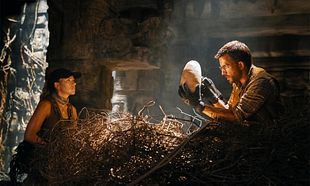Eames? That's the dude that invented that chair, right? As this documentary sees it, to dismiss the fascinating Charles and Ray Eames as a couple that just designed a chair is akin to saying,' Earth? That's the place with trees, right?' Jason Cohn and Bill Jersey delve into the artistic ways of the husband-and-wife team - he an architect who dropped out of college, she a painter - who designed, among many, many other things, a seat we've all sat in. You're probably sitting in one now.
Blessed with endless footage of the pair and the collaborators doing their thing, James Franco's narration stitches together the visuals, linking the photos and short films to the talking heads that are forever ready with a trailer-friendly sound bite. Franco ventures that their office was 'one of the most creative addresses on earth" and that his short films 'were not motivated by profit' (Fair enough, James, who is reading from Cohn's at times on-the-nose script). Amongst the grandiose statements made by friends, employees and critics who climb on top of each other to deliver the best compliment, Taxi Driver writer Paul Schrader's notion that the immediately recognisable Victorian era is just as familiar to us as 'the Eames era' seems a bit much.
Schrader was describing something else when he said, 'excessive informatio dizzying information,' but he could have well have been talking about the documentary itself. The Architect And The Artist is a stream of interesting fact after fascinating titbit; you get the feeling you're only getting half the story of these two remarkably talented people. IBM have them to thank for changing their image to appease computer-phobe tensions in the sixties. They're also credited here with easing Cold War fears.
Where Cohn and Jersey stop short is the marriage itself, which is a shame because it was as much about the two minds meeting and feeding each other than about the finished products. The directors touch on the sexual politics of the day - a TV show presenter is dismissive of Ray's involvement, she being the little woman and all - and how that affected their relationship and how Ray was pushed into the background. But sadly that isn't explored further. However, what is refreshing in the days of hagiographic documentaries is this isn’t shy about exploring Charles Eames' extra marital activities and his tendency to take credit for what was essentially a collaborative process.









































































